Morning glory sweet potato: features, varieties and their cultivation
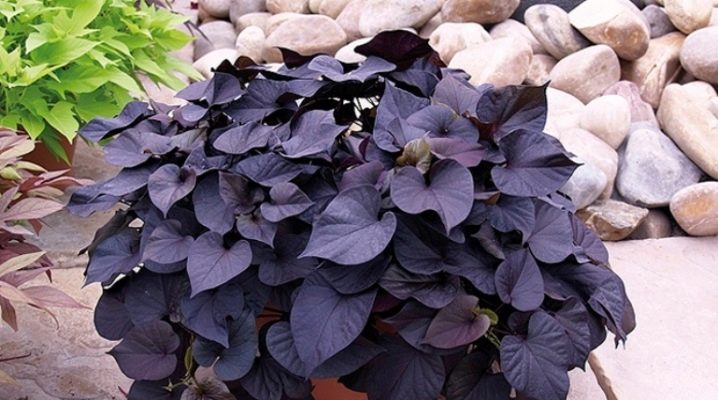
Previously, morning glory sweet potato was cultivated as an edible plant, and only recently gardeners have started growing it for decorative purposes. This amazing plant with leaves of different shades creates a picturesque landscape at the summer cottage.


Description of culture
The roots of the morning glory sweet potato can be eaten, but today this plant is grown for indoor and garden landscaping. Also, the plant often decorates balconies, loggias and terraces.
The plant belongs to the Bindweed family, its homeland is Mexico and the lands of the central part of the American continent - it is there that you can see almost two-thirds of all existing varieties of this flower.
The leaf plates are well spaced heart-shaped lobes. The size of the leaf plates is close to 15 cm. A distinctive feature is the color range, represented by the most interesting shades of green, purple, scarlet and yellow. Feathery plants are also found.
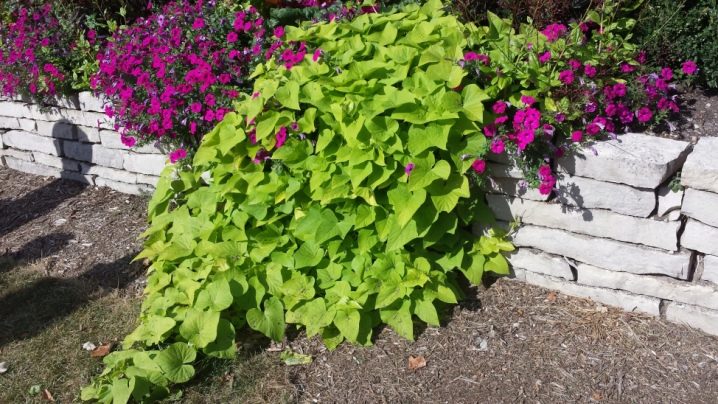
The sweet potato grows up to 30 cm, but the lashes can reach 2.5 meters, and the total length reaches 5 meters. It blooms with pretty beautiful axillary flowers, however, some recently bred varieties do not produce flowers.
In southern latitudes, plants are used as a ground cover crop and decorate flower beds - they prefer well-lit areas and a sufficient amount of their air.
In Russia, it is mainly grown as a loach that adorns arches, fences, walls and windows. Ipomoea sweet potato is very fond of landscape designers, as it allows you to successfully hide any flaws in the garden plot, since this flower grows very quickly and covers the support in just a few weeks.

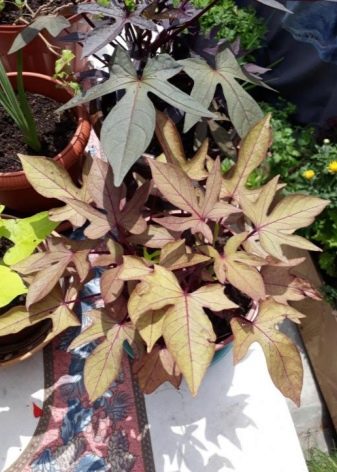
Varieties
Among the popular varieties and varieties of decorative leafy morning glory, the following should be distinguished:
- Ligth green - decorative loach with light green leaves, visually reminiscent of 5 elongated and pointed at the ends of the blades;

- Sweet caroline bronze - another plant with leaf blades of five sharply broken blades of a light bronze shade;

- Sweet caroline purple - a variety with large carved leaves of a rich lilac-purple color;
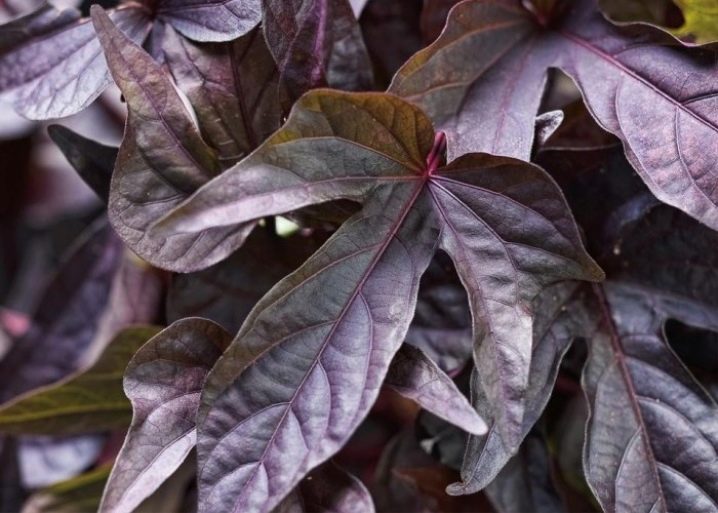
- Sweet heart red - the leaf plates of this morning glory resemble maple ones, the color has a green-purple tint, and the young leaves are rather brown.
In most cases, morning glory is grown outdoors. But there are several varieties adapted for home life.
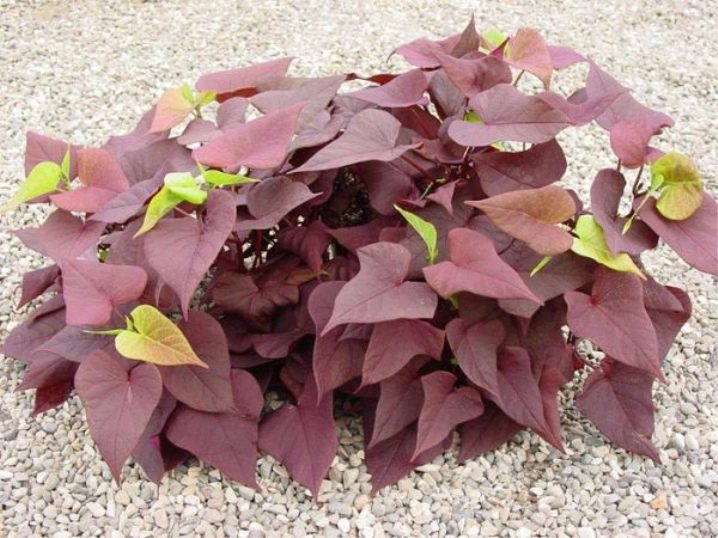
- Kumara Ed. This plant has lush large leaves, oval yellow tubers. This variety requires warmth and good lighting, so it needs additional lighting at home.


- Burgundy. It is one of the earliest species of morning glory. The tubers are bright red, and the large leaves are green. The inflorescences have a pleasant aroma.


Purple. This variety is considered early. It is adapted to be kept in apartments. The leaf plates have a deep green color, the bush is quite powerful and strong. The plant is characterized by resistance to most infections - it is for this reason that quite a few hybrids have been derived on its basis, which can be conditionally divided into several categories:
- dessert - this includes such varieties as Amish Red, as well as "Chestnut" and "Purple Korean";
- vegetable - represented by a series of varieties Beauregarde, California Gold and South Queen;
- fodder - the most popular were the "White bouquet" and the variety of morning glory "Brazilian".
The dessert group includes sweet potatoes, which have a pleasant taste reminiscent of pumpkin, banana and melon. These varieties are widely used in the preparation of all kinds of desserts and preserves, as well as in winemaking.
A group of vegetable varieties can easily replace potatoes in any dish, and sweet potatoes are grown for fodder for farm animals.



Landing
Indoor morning glory requires a water and air permeable substrate. She is suitable for universal soil for indoor crops, which is sold in any flower shop. If you wish, you can make a suitable mixture of different soils yourself. To do this, you need to take ordinary garden soil, disinfect it by calcining in a pan and add a little humus, as well as potash and phosphorus fertilizers. If the usual soil turns out to be too acidic, then it must be additionally mixed with crushed ash or a little lime added.
Morning glory loves lush land, but it is worth noting that even if you plant it in the most ordinary soil, it will grow and give flowers, but not as abundantly as we would like.
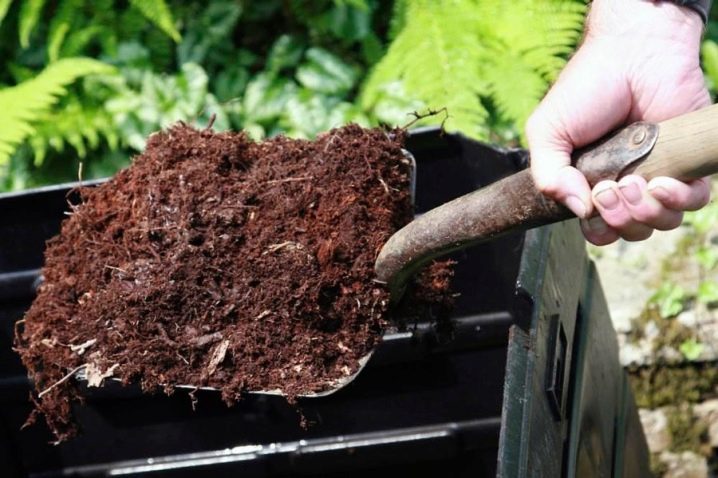
Most often, morning glory is grown from seeds. This planting material retains a high germination capacity for about 3-4 years. The seedlings must undergo stratification and lie in warm water for 24 hours - during this time the seeds will swell. If this does not happen, then they need to be pierced with a needle and sent into the water for a few more hours.
Seeds can be planted in containers for germination in late February or early March for seedlings, or you can plant them directly in open ground. In the latter case, planting should be carried out in the second decade of May, when the threat of return cold has completely passed, and a consistently high day and night temperature will be established.
Plants are planted at a distance of 20-25 cm from each other. It is advisable to make a light frame over the flower bed, which future vines will use as a support.

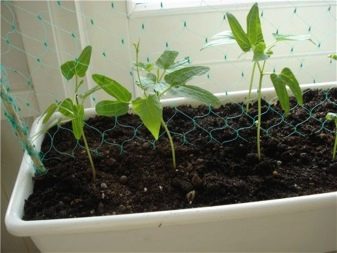
How to care?
Morning glory is a rather unpretentious plant, but for its full flowering it is necessary to create a favorable habitat.
Sweet potato prefers well-lit and windless areas, but it is undesirable to grow it in the shade - the plant, in search of light, will begin to stretch, fade and lose its decorative effect. Planting is carried out in the spring, and in the fall the bush itself will dry out naturally.

If a perennial variety grows, and it is necessary to preserve it in winter, then shortly before the onset of frost, the top of the lashes should be cut off, carefully dug up and transplanted into a pot, then brought home and left in a warm room. It is very important at this moment, so that the morning glory is located as close to the window as possible - she needs fresh air. At the same time, cold drafts should not be allowed - with a significant decrease in the temperature in the room, the sweet potato sheds its leaves.
This flower is rightfully considered a godsend for too busy or simply forgetful owners - it does not require regular watering at all. Moreover, morning glory is very afraid of waterlogging - frequent irrigation is required only in the very first weeks. If the plant is planted on a balcony or in the open field, then it is watered only in extreme heat twice a week. During the rains, watering is excluded.
With excessive moisture, blisters of a light shade appear on the leaves of the sweet potato - this is how the plant reacts to excess water. If such a symptom is found, watering should be stopped until the blisters come off.
When kept at home, watering is preferable, in which water is added to the pan - the plant itself will take as much moisture as it needs.
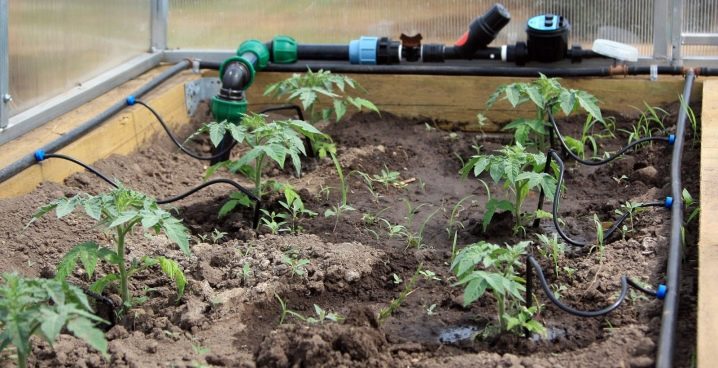
Spraying for morning glory is not recommended, but once every three months, you need to wipe the sheet plates with a soft sponge dipped in settled water to clean them of dust and dirt.
At low temperatures, the plant dies rather quickly, so you can take out the container with a flower outside only after the temperature at night stops at around 20 degrees and above. This fully applies to planting in open land.
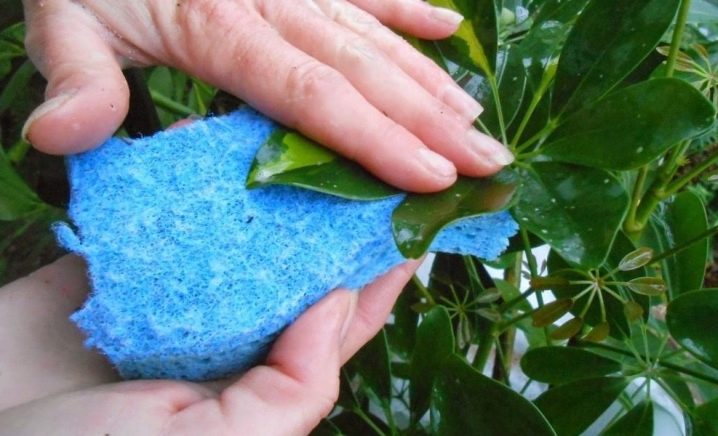
Reproduction
Morning glory sweet potato can reproduce in two ways: vegetatively and by seed.
The first option involves cultivation of tubers and cuttings. In this case, the tubers must be dug up in the fall, even before the onset of frost.
This process should be done carefully and then stored in a cool, dark place.
Usually in the month of December, kidneys appear on them. Then the tuber needs to be moved to a nutritious substrate - usually peat is mixed with river sand. However, regular flower primer will work as well.
When the seedlings appear, you can divide the tubers into 2-4 parts with a sharp knife and plant each in a separate container for growing. With the onset of heat, the planting material moves into the pots.


This method is only good if the plant has developed tubers. In this case, up to 15-20 young plants can be obtained from each bush. But the fact is that in most varieties of tubers develop very slowly, so in the first year it is not possible to get high-quality seed material.
Ipomoea can be propagated by cuttings, which can be obtained from sprouted tubers. They are washed under running water so that all the milky juice comes out, dried in the open air for two hours and sent into the water for rooting.
You can also get cuttings from purchased seedlings. In this case, a shoot of 10-15 cm is cut off, while it is imperative to capture several leaf nodes.

Rooting is carried out in a warm, well-lit place. During this time, the shoots are stretched, so after a while they are re-pruned, stimulating the growth of lateral branches - this is already a seedling that can be transplanted into open ground at the beginning of summer.
A characteristic feature of morning glory is a rather rapid formation of the root system - you can get full-fledged roots already on the fifth day, so there is no need to use "Kornevin" and other drugs of a similar effect.
Ipomoea can be propagated by seeds.... But this method is used quite rarely - they germinate for a very long time, so you can enjoy all the beauty of this plant no earlier than in the second half of summer.
Diseases and pests
Morning glory sweet potato belongs to very resistant plants - it rarely gets sick, and insects hardly attack it.
However, due to improper care or due to infection from neighboring flowers, it can pick up such a dangerous disease as root rot.
If this happens, then you should immediately pull out the morning glory from the container, clean off all the soil from the roots and tuber, then cut it off with a knife to the affected area, and treat the remaining parts with copper sulfate or Bordeaux mixture. The drug "Cytoflavin" also has good efficiency.
Of the pests of morning glory, it is susceptible only to the spider mite, which is impossible to get rid of with folk remedies, such as a concentrated solution of laundry soap or tincture of tobacco. Only chemical insecticidal preparations "Actellik", "Oberon" or "Envidor" can help the plant.


Use in landscape design
Planting several varieties of morning glory on one flowerbed, you can create a very bright and effective color composition that will decorate any garden plot. Morning glory sweet potato grows rather quickly, so it has found its application in landscape design as a ground cover crop - its stems can take root at the points of internodes.If you wish, you can always lift the sweet potato from the ground and fix it on a high support.
More popular ampel cultivation of morning glory... In this case, it is planted in decorative hanging pots and flowerpots.


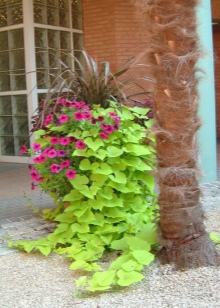
For the care, rooting and cultivation of morning glory sweet potatoes, see the following video.


































































































The comment was sent successfully.